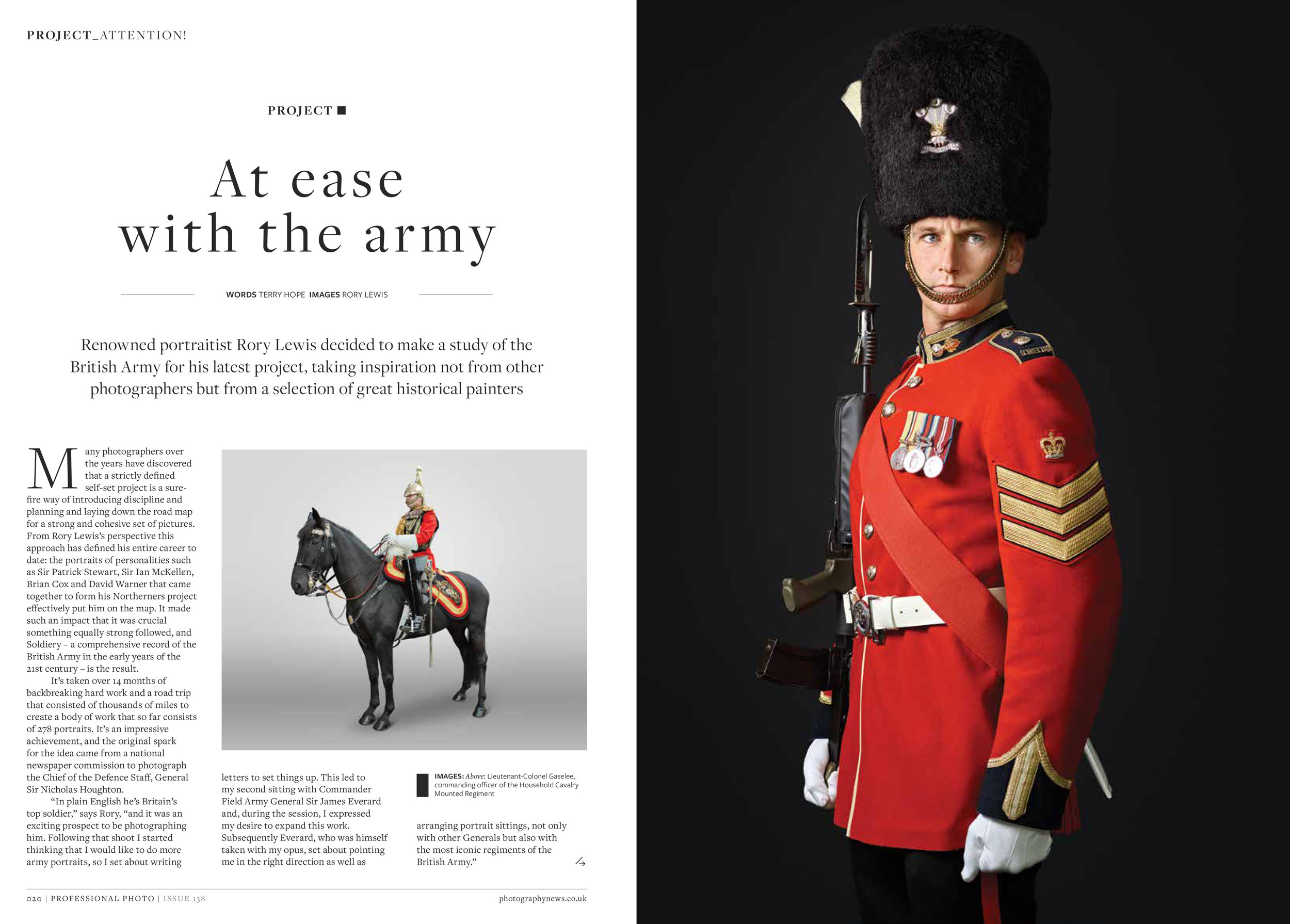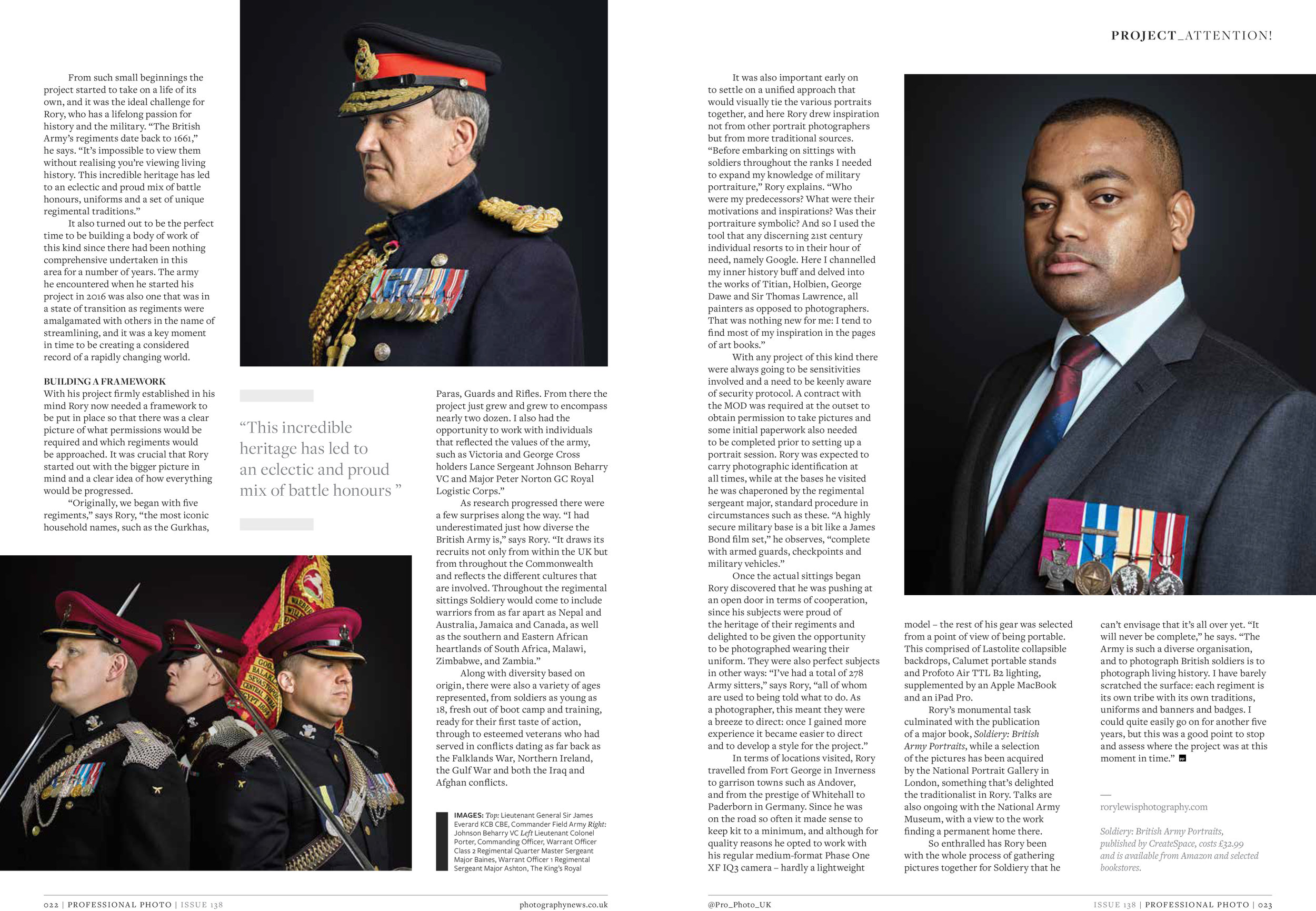It’s taken over 14 months of backbreaking hard work and a road trip that consisted of thousands of miles to create a body of work that so far consists of 278 portraits. It’s an impressive achievement, and the original spark for the idea came from a national newspaper commission to photograph the Chief of the Defence Staff, General Sir Nicholas Houghton.
“In plain English he’s Britain’s top soldier,” says Rory, “and it was an exciting prospect to be photographing him. Following that shoot I started thinking that I would like to do more army portraits, so I set about writing letters to set things up. This led to my second sitting with Commander Field Army General Sir James Everard and, during the session, I expressed my desire to expand this work. Subsequently Everard, who was himself taken with my opus, set about pointing me in the right direction as well as arranging portrait sittings, not only with other Generals but also with the most iconic regiments of the British Army.”
From such small beginnings the project started to take on a life of its own, and it was the ideal challenge for Rory, who has a lifelong passion for history and the military. “The British Army’s regiments date back to 1661,” he says. “It’s impossible to view them without realising you’re viewing living history. This incredible heritage has led to an eclectic and proud mix of battle honours, uniforms and a set of unique regimental traditions.”
It also turned out to be the perfect time to be building a body of work of this kind since there had been nothing comprehensive undertaken in this area for a number of years. The army he encountered when he started his project in 2016 was also one that was in a state of transition as regiments were amalgamated with others in the name of streamlining, and it was a key moment in time to be creating a considered record of a rapidly changing world.
BUILDING A FRAMEWORK
With his project firmly established in his mind Rory now needed a framework to be put in place so that there was a clear picture of what permissions would be required and which regiments would be approached. It was crucial that Rory started out with the bigger picture in mind and a clear idea of how everything would be progressed.
“This incredible heritage has led to an eclectic and proud mix of battle honours ”
“Originally, we began with five regiments,” says Rory, “the most iconic household names, such as the Gurkhas, Paras, Guards and Rifles. From there the project just grew and grew to encompass nearly two dozen. I also had the opportunity to work with individuals that reflected the values of the army, such as Victoria and George Cross holders Lance Sergeant Johnson Beharry VC and Major Peter Norton GC Royal Logistic Corps.”
As research progressed there were a few surprises along the way. “I had underestimated just how diverse the British Army is,” says Rory. “It draws its recruits not only from within the UK but from throughout the Commonwealth and reflects the different cultures that are involved. Throughout the regimental sittings Soldiery would come to include warriors from as far apart as Nepal and Australia, Jamaica and Canada, as well as the southern and Eastern African heartlands of South Africa, Malawi, Zimbabwe, and Zambia.”
Along with diversity based on origin, there were also a variety of ages represented, from soldiers as young as 18, fresh out of boot camp and training, ready for their first taste of action, through to esteemed veterans who had served in conflicts dating as far back as the Falklands War, Northern Ireland, the Gulf War and both the Iraq and Afghan conflicts.
It was also important early on to settle on a unified approach that would visually tie the various portraits together, and here Rory drew inspiration not from other portrait photographers but from more traditional sources. “Before embarking on sittings with soldiers throughout the ranks I needed to expand my knowledge of military portraiture,” Rory explains. “Who were my predecessors? What were their motivations and inspirations? Was their portraiture symbolic? And so I used the tool that any discerning 21st century individual resorts to in their hour of need, namely Google. Here I channelled my inner history buff and delved into the works of Titian, Holbien, George Dawe and Sir Thomas Lawrence, all painters as opposed to photographers. That was nothing new for me: I tend to find most of my inspiration in the pages of art books.”
With any project of this kind there were always going to be sensitivities involved and a need to be keenly aware of security protocol. A contract with the MOD was required at the outset to obtain permission to take pictures and some initial paperwork also needed to be completed prior to setting up a portrait session. Rory was expected to carry photographic identification at all times, while at the bases he visited he was chaperoned by the regimental sergeant major, standard procedure in circumstances such as these. “A highly secure military base is a bit like a James Bond film set,” he observes, “complete with armed guards, checkpoints and military vehicles.”
Once the actual sittings began Rory discovered that he was pushing at an open door in terms of cooperation, since his subjects were proud of the heritage of their regiments and delighted to be given the opportunity to be photographed wearing their uniform. They were also perfect subjects in other ways: “I’ve had a total of 278 Army sitters,” says Rory, “all of whom are used to being told what to do. As a photographer, this meant they were a breeze to direct: once I gained more experience it became easier to direct and to develop a style for the project.”
In terms of locations visited, Rory travelled from Fort George in Inverness to garrison towns such as Andover, and from the prestige of Whitehall to Paderborn in Germany. Since he was on the road so often it made sense to keep kit to a minimum, and although for quality reasons he opted to work with his regular medium-format Phase One XF IQ3 camera – hardly a lightweight model – the rest of his gear was selected from a point of view of being portable. This comprised of Lastolite collapsible backdrops, Calumet portable stands and Profoto Air TTL B2 lighting, supplemented by an Apple MacBook and an iPad Pro.
Rory’s monumental task culminated with the publication of a major book, Soldiery: British Army Portraits, while a selection of the pictures has been acquired by the National Portrait Gallery in London, something that’s delighted the traditionalist in Rory. Talks are also ongoing with the National Army Museum, with a view to the work finding a permanent home there.
So enthralled has Rory been with the whole process of gathering pictures together for Soldiery that he can’t envisage that it’s all over yet. “It will never be complete,” he says. “The Army is such a diverse organisation, and to photograph British soldiers is to photograph living history. I have barely scratched the surface: each regiment is its own tribe with its own traditions, uniforms and banners and badges. I could quite easily go on for another five years, but this was a good point to stop and assess where the project was at this moment in time.”


